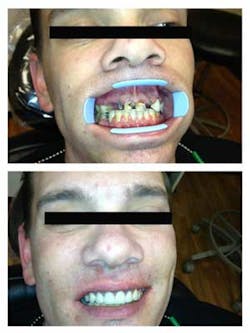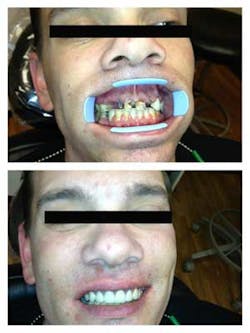Meth mouth and the ravages of an addiction: from a dental perspective
In today’s pop culture, meth is quickly becoming part of the lexicon of a broad audience. Having been featured in the popular program “Breaking Bad,” meth has regained a popularity not seen in two decades. Currently, meth is a featured player in “Homefront,” a film starring Jason Statham and James Franco. Increasingly in the public radar, meth is being referenced as Generation Y’s LSD. Its popularity is growing and its audience is broad, ranging from the coastal hipster to the urban barista. Despite meth’s cultural awareness becoming ever popular, its oral health ramifications must not be understated.
Meth, short for methamphetamine, is highly addictive and its allure is that it takes users on a psychedelic adventure promising an unmatched euphoria. Despite its association with the hallucinogenic LSD because of its similar high, meth’s side affects are significantly more deleterious to one’s health. Drugs such as LSD and Shrooms may cause similar euphoric feelings but they do not cause the same type of tissue destruction that chronic meth abuse does. Despite its potent hallucinogenic abilities, the oral health effects of LSD are negligent compared to the destruction and mutilation of teeth that occurs with prolonged meth abuse.
ADDITIIONAL READING ...
Getting personal about designer drugs
Diversion and addiction among dental professionals
Professional addiction: The first step is admitting the problem
With chronic meth abuse, the progress of dental decay can be swift and the destruction of teeth, obliteration of enamel, and damage to the nerve pulp occurs rapidly. The severe damage of teeth that occurs from chronic meth abuse is so rampant that it has its own classification: meth mouth. Unlike the side effects of other euphoria-generating drugs, the dental problems from meth mouth are visible. Internally, there is also significant organ damage and accelerated tissue aging as a result of chronic meth abuse.
Patient J.T. (chronic meth user) before and after treatment
The exact cause of meth mouth is unknown, except that extreme dry mouth, severe tooth decay, gum disease, poor oral hygiene, low nutrition, teeth grinding, and overall neglect become causative factors. Meth mouth is a serious problem that generally starts with bad breath, cavities, and progressively swollen, bleeding, and red gums. The later stages progress to a state in which teeth can become completely obliterated.
How does meth destroy teeth?
The extreme dry mouth (xerostomia) that results from meth abuse leads to a progression of decay along the gumline. In an extreme dry mouth environment, there is a significant decrease in salivary enzymes that kill the bacteria that cause cavities and gum disease. In addition, when meth abusers are high, many partake in “buzzing,” where they will consume sugary foods and soda during cravings. The acids in the soda and the glucose in the sugary foods facilitate bacteria to continue their proliferation.
In the late stages of meth mouth, the results are debilitating. After a continuous cycle of neglectful oral hygiene, dry mouth, rampant tooth decay, progressive gum disease, and a high-risk diet, teeth can decay to the gumline. This is when teeth can fall out and become decayed all the way to their roots. With many meth abusers, a long-term paranoia may also settle in, resulting in teeth grinding that catalyzes the fracture of teeth and tooth loss, resulting in partial and sometimes full edentulism.
Due to the ease of making meth, its accessible ingredients, and growing popularity, it is absolutely critical that its dire dental consequences be highlighted in the media, similar to the graphic anti-tobacco ads. Long-term meth abusers can experience rampant tooth decay, tooth loss, loss of taste, and an inability to chew. The dental consequences can be catastrophic. The oral tissue destruction can lead individuals into a downward spiral of further neglect, depression, and loss of self worth.
The dental effects of meth are the most damaging compared to that of other drugs. Long-term use of LSD, heroin, and mushrooms have deleterious cognitive consequences, but they do not destroy the mouth as much as meth abuse. Abusers must seek counseling to stop meth abuse as soon as possible. Chronic abuse can destroy one’s smile and eventually one’s life. Despite the high and perceived joy attained from meth abuse, the resulting effects of meth mouth are no laughing matter.
ALSO BY DR. IMAN SADRI ...
The economics of ergonomics: 3 steps to maintain longevity throughout your dental career
An argument for clear aligners and clear braces
Interview With a Dental Icon: Dr. Bill Dorfman
Interview With a Dental Icon: Dr. Larry Rosenthal
Do you ask your dental patients if they snore?



